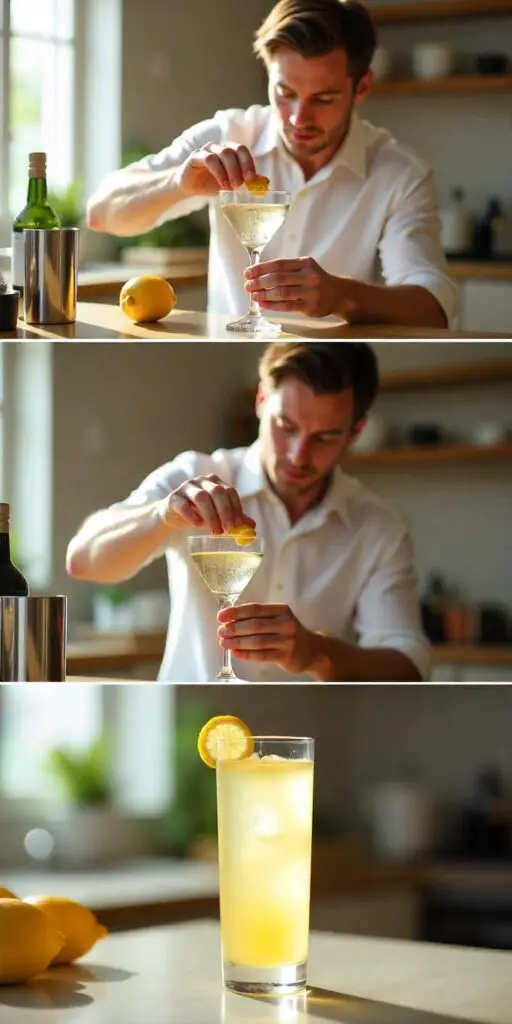Elegant, effervescent, and delightfully citrusy, the French 75 Recipe is a timeless classic in the world of cocktails. First crafted during World War I and named after the powerful French 75mm field gun, this cocktail packs a punch wrapped in a silky, refined presentation. Made with gin, fresh lemon juice, simple syrup, and topped with champagne, it’s the perfect marriage of spirit, citrus, and sparkle. The French 75 is a favorite for celebrations, brunches, and sophisticated evening soirées. Whether you’re a cocktail connoisseur or a curious home bartender, this refreshing drink is a must-try for anyone looking to elevate their mixology game.
A classic among classics, the French 75 blends the botanical notes of gin with the crisp brightness of lemon and the bubbly charm of champagne, creating a well-balanced drink that’s as invigorating as it is refined. Let’s dive into how to make the perfect French 75, from ingredients to instructions, with helpful tips along the way.
Nutrition & Instructions
- Prep Time: 5 minutes
- Active Time: 5 minutes
- Resting Time: 0 minutes
- Total Time: 5 minutes
- Cuisine: French, American
- Course: Beverage, Cocktail
- Servings: 1 cocktail
- Calories per Serving: ~140 kcal
Equipment
- Cocktail shaker
- Jigger or measuring tool
- Champagne flute or coupe glass
- Fine mesh strainer (optional)
- Citrus juicer
- Bar spoon (optional)
Ingredients
- 1 oz gin (London Dry gin recommended)
- ½ oz fresh lemon juice (about half a lemon)
- ½ oz simple syrup (1:1 ratio of sugar and water)
- 3 oz chilled champagne (or other sparkling wine like prosecco or cava)
- Ice
- Lemon twist (for garnish)
Instructions
Step 1: Chill Your Glass
Begin by placing your champagne flute or coupe glass in the freezer or filling it with ice water while you prepare the cocktail. A chilled glass keeps your drink crisp and refreshing.
Step 2: Shake the Base Ingredients
In a cocktail shaker, combine the gin, fresh lemon juice, and simple syrup. Fill the shaker with ice and shake vigorously for about 10-15 seconds. This helps to mix the ingredients and chill the drink.
Step 3: Strain into Glass
Remove your chilled glass from the freezer or discard the ice water. Strain the mixture into the flute or coupe using a fine mesh strainer to remove any ice shards or pulp for a smooth finish.
Step 4: Top with Champagne
Carefully top the cocktail with the chilled champagne. Pour slowly to avoid too much fizz overflowing. Aim for about 2.5 to 3 ounces depending on your glass size and taste preference.
Step 5: Garnish and Serve
Garnish with a lemon twist or a thin lemon peel spiral. This adds a lovely aroma and visual elegance to the drink. Serve immediately while it’s still effervescent.
Tips for Best Results
- Use Fresh Lemon Juice: Freshly squeezed lemon juice elevates the drink’s flavor and adds bright acidity.
- Chill Everything: Keep your gin, champagne, and glass cold to maintain the cocktail’s refreshing crispness.
- Adjust the Sweetness: If you prefer a drier cocktail, reduce the amount of simple syrup or opt for a brut champagne.
- Choose Quality Gin: A good London Dry gin with botanical complexity complements the lemon and champagne perfectly.
- Try Variations: You can substitute cognac for gin to make a more traditional, richer version of the French 75.
Flavor Profile
- Aroma: Citrusy and floral with notes of botanicals from the gin
- Taste: A delicate balance of tart lemon, subtle sweetness, and effervescent dryness from champagne
- Mouthfeel: Light, bubbly, and crisp
Variations and Substitutions
- Cognac Instead of Gin: The original French 75 was actually made with cognac. This version is smoother and slightly richer.
- Prosecco or Cava: If champagne isn’t available, other dry sparkling wines work just as well.
- Lavender Simple Syrup: Adds a floral twist for a unique version perfect for spring and summer events.
- Elderflower Liqueur: Replace simple syrup with a splash of elderflower liqueur for a sweet, floral profile.
When to Serve
- Celebrations and Toasts: Perfect for weddings, anniversaries, and New Year’s Eve.
- Brunch: A sophisticated alternative to the mimosa.
- Cocktail Parties: Light and bubbly, ideal for social gatherings.
- Pre-Dinner Aperitif: Stimulates the appetite with its citrusy brightness.
Pairing Suggestions
- Appetizers: Goat cheese crostini, smoked salmon blinis, or charcuterie boards
- Main Dishes: Grilled seafood, roasted chicken, or light pasta dishes with lemon or herbs
- Desserts: Lemon tarts, macarons, or berry parfaits
History of the French 75
The French 75 was first recorded in 1915 at Harry’s New York Bar in Paris, a popular haunt for American expatriates and soldiers during World War I. The drink was named after the French 75mm field gun, known for its powerful punch, mirroring the strength of this seemingly light cocktail. It gained popularity in post-war years, especially in American cocktail bars, and made its way into literature, films, and cocktail menus around the world. Over the years, the gin-based version became more common in the U.S., while the cognac version remained popular in France.
Nutritional Information (Approximate per Serving)
- Calories: 140 kcal
- Carbohydrates: 7g
- Sugar: 6g
- Fat: 0g
- Protein: 0g
- Alcohol by Volume (ABV): ~12–15% depending on the proportions and champagne used
Storage and Make-Ahead Tips
- Make the Base Ahead: Mix lemon juice, simple syrup, and gin ahead of time and refrigerate until ready to serve.
- Don’t Add Champagne in Advance: Always add sparkling wine just before serving to preserve bubbles.
- Batch Preparation: For parties, scale up the base ingredients, keep chilled in a pitcher, and top each glass with champagne to order.
Conclusion
The French 75 Recipe delivers elegance in a glass, combining zesty citrus with botanical gin and the celebratory sparkle of champagne. Whether you’re toasting a special occasion or enjoying a quiet evening in style, this cocktail brings a timeless charm to any moment. With simple ingredients, quick prep, and dazzling results, the French 75 is a brilliant addition to any bartender’s repertoire. Try it today and experience the refreshing sophistication of this iconic drink.

I am Ashley Doyle, Senior Specialist in Food & Policy at The Humane Society of the United States and editor at airfryermama.com. I am passionate about transforming our global food system by promoting delicious, climate-friendly, plant-based foods. After transitioning from law to food and public policy, I now work with major food service companies to develop plant-based initiatives and animal welfare policies. My goal is to drive institutional change to combat climate change and improve our food system.





